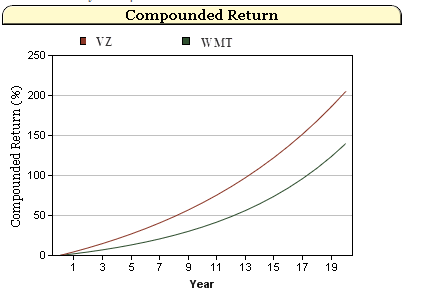When looking to build a long-term portfolio of stocks that pay high dividends, investors usually come up with a mix of stocks that either have high dividend yields or high dividend growth rates. It is difficult to find good companies that have both. This means that there is often a choice to be made. All else equal, should one invest in the company that has that enticing high dividend yield, but a low dividend growth rate, or does one exude patience and invest in the company with a relatively low yield, but a high dividend growth rate? To help answer this question I looked at two companies that offer these different alternatives: Verizon (VZ) and Wal-Mart (WMT).
| VZ: | | Div Yield | 1 Yr Div
Growth Rate | 5 Yr Div
Growth Rate | | | 4.6% | 3.0% | 4.0% | | | | | WMT: | | Div Yield | 1 Yr Div
Growth Rate | 5 Yr Div
Growth Rate | | | 2.1% | 9.0% | 16.2% | | |
There are clear differences in the two companies’ dividend yields as well as the growth rates. This presents a great case study in which company will give the investor a better return due to dividends over time. More specifically, I want to measure the Yield on Cost (YOC) and how it changes over time as well as the compounded annual return due to dividends. The YOC simply measures the annual dividend divided by the original investment in the company’s stock.
I ran the following analysis in our free calculator called Dividend Yield And Growth. Starting with the simplified assumption that the growth rate of each dividend follows the five year growth rate, we see the following:

It takes about 15 years for the YOC for Wal-Mart to break even with the YOC for Verizon. Of course, due to compounding we see the YOC for Wal-Mart explode upward eventually. But this assumes that the company can continue its relatively high rate of dividend growth going forward.
Even more important than the YOC is the compounded total return over time. Even if we assume that Wal-Mart’s dividend growth rate continues at this relatively high rate, the compounded return for Wal-Mart will never break even with Verizon over a 20 year time frame. It is also important to note that I do not consider any price appreciation in these calculations and compounded returns are due solely to dividends.

What if instead we used the five year growth rate of dividends? In this scenario Wal-Mart will outperform over a 20 year time frame. The compounded return vs. Verizon will be 332% vs. 230% and the annual rate of return will be 7.6% vs. 6.1%
These scenarios show just how important the growth rate of dividends are over time. When attempting to figure out which dividend payers to invest in you should have an idea of what the dividend growth rate will be going forward. Otherwise it is very tough to make a decision as to which investment will pay off in the long-run.